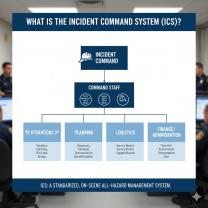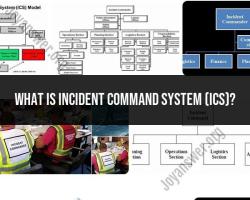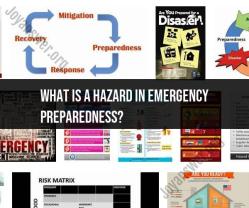What is Incident Command System (ICS)?
The Incident Command System (ICS) is a standardized management system used by emergency response agencies and organizations to effectively manage and coordinate responses to incidents, emergencies, and disasters. It provides a flexible framework for command, control, and coordination of resources during various types and sizes of incidents, from small-scale events to large complex disasters.
Key concepts and components of the Incident Command System include:
Unified Command Structure: ICS establishes a clear command structure with defined roles and responsibilities. It typically includes Incident Commanders, Operations Section, Planning Section, Logistics Section, and Finance/Administration Section.
Common Terminology: ICS uses standardized terminology to ensure clear communication across different agencies and disciplines involved in the response. This common language helps prevent misunderstandings and enhances coordination.
Modular Organization: ICS can expand or contract based on the needs of the incident. It is scalable and adaptable, allowing resources to be efficiently managed based on the incident's scope and complexity.
Management by Objectives: Incident objectives and goals are established to guide the response efforts. These objectives are developed based on situational assessments and priorities.
Incident Action Planning: ICS promotes the development of an Incident Action Plan (IAP) that outlines strategies, tactics, and resources needed to achieve the established objectives. The plan is continuously evaluated and adjusted as the situation evolves.
Resource Management: ICS includes processes for identifying, ordering, mobilizing, tracking, and demobilizing resources such as personnel, equipment, and supplies required for the response.
Integrated Communications: Effective communication is essential in ICS. It ensures that information flows accurately and efficiently among all levels of responders and agencies involved in the incident.
Chain of Command and Unity of Command: ICS establishes a clear hierarchy of command and ensures that individuals report to only one supervisor, preventing confusion and conflicting directives.
Accountability and Documentation: ICS emphasizes the need for accurate record-keeping, documentation of actions taken, resource use, and incident decisions to ensure accountability and facilitate post-incident analysis.
Ongoing Evaluation and Improvement: After-action reviews and continuous evaluation are integral parts of ICS. It allows organizations to assess the effectiveness of the response and identify areas for improvement.
ICS is widely used in the United States and internationally across emergency response agencies, including fire departments, law enforcement, emergency medical services, public health agencies, and other organizations involved in emergency management. Its standardized approach fosters a coordinated and efficient response to incidents while maintaining safety and minimizing the impact on communities.
What does the Incident Command System (ICS) entail and how is it utilized in emergency management?
The Incident Command System (ICS) is a standardized, on-scene management concept used for coordinating the response to and mitigation of a wide range of incidents, from small-scale emergencies like medical situations to large-scale disasters such as wildfires or terrorist attacks. It provides a flexible and scalable framework for organizing and deploying resources effectively in a complex and often chaotic environment.
Here's what the ICS entails:
Structure:
- Unified command: A single incident commander (IC) has overall authority and decision-making responsibility.
- Management branches: The IC delegates tasks to various branches responsible for specific functions, such as operations, planning, logistics, finance/administration, and public information.
- Organizational units: Within each branch, smaller units are formed as needed to address specific tasks, such as search and rescue teams, medical aid stations, or security checkpoints.
Principles:
- Unity of command: Each task has a single designated leader to avoid confusion and conflicting orders.
- Span of control: The IC should manage a limited number of subordinates to ensure effective communication and oversight.
- Flexibility: The system can be adapted to various incident types and sizes.
- Scalability: Resources can be easily added or removed based on the incident's needs.
- Common terminology: Standardized terms and phrases facilitate communication and teamwork between different agencies and personnel.
Benefits of using ICS in emergency management:
- Improved coordination: ICS enhances communication and collaboration between various responders, preventing duplication of efforts and ensuring a unified response.
- Effective resource management: The system helps allocate and utilize personnel, equipment, and supplies efficiently.
- Enhanced decision-making: Clear reporting structures and shared situational awareness enable informed decisions by the incident commander.
- Scalability and adaptability: ICS can be readily adapted to various types and sizes of incidents, ensuring an effective response regardless of the situation.
- Training and standardization: Widespread adoption of ICS facilitates seamless collaboration between different jurisdictions and agencies during emergencies.
Overall, the Incident Command System provides a valuable framework for managing complex and dynamic emergency situations. Its standardized structure, principles, and benefits make it a crucial tool for ensuring effective and coordinated response by first responders and emergency management personnel.
I hope this explanation clarifies what the ICS is and how it's utilized in emergency management. Feel free to ask if you have any further questions about specific aspects of the system or its practical implementation during emergencies.





